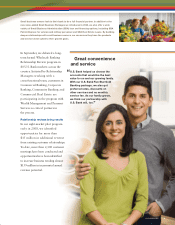US Bank 2008 Annual Report Download - page 21
Download and view the complete annual report
Please find page 21 of the 2008 US Bank annual report below. You can navigate through the pages in the report by either clicking on the pages listed below, or by using the keyword search tool below to find specific information within the annual report.Management’s Discussion and Analysis
OVERVIEW
In 2008, U.S. Bancorp and its subsidiaries (the “Company”)
continued to demonstrate financial strength despite
significant weakness in the domestic and global economy.
Difficulties which began in the mortgage lending and
homebuilding industries in 2007 expanded to many other
sectors in 2008, as the impact of mortgage delinquencies,
defaults and foreclosures, and falling housing values affected
consumer confidence and led to a domestic recession in the
United States. Despite these challenges, the Company’s
comparative strength enabled it to attract significant new
customers, and invest in business initiatives that strengthen
its presence and product offerings for customers. While not
immune to current economic conditions, the Company’s well
diversified business has provided substantial resiliency to the
credit challenges faced by financial institutions in today’s
environment.
Despite the market challenges, the Company earned
$2.9 billion in 2008. Additionally, the Company’s balance
sheet is strong, reflecting prudent credit underwriting and
allowance for credit losses, and strong capital and liquidity.
In late 2008, the Company also increased its regulatory
capital through the sale of $6.6 billion in preferred stock
and warrants to the United States Treasury through the
Capital Purchase Program. At December 31, 2008, the
Company’s Tier 1 capital ratio was 10.6 percent and its total
risk-based capital ratio was 14.3 percent. Credit rating
organizations rate the Company’s debt among the highest of
the Company’s large domestic banking peers, demonstrating
the Company’s financial strength. At December 31, 2008,
the Company’s tangible common equity divided by tangible
assets was 3.2 percent (4.5 percent excluding accumulated
other comprehensive income (loss)).
In 2008, the Company grew its loan portfolio and
increased deposits significantly, both organically and through
acquisition, including operations acquired from the Federal
Deposit Insurance Corporation (“FDIC”). The Company’s
organic loan growth was $18.4 billion (12.0 percent) in
addition to $13.0 billion of acquired loans. Organic deposit
growth was $14.4 billion (11.0 percent) in addition to
$13.5 billion assumed in acquisitions. Although the balance
sheet grew, increasing net interest income, net income
decreased $1.4 billion from 2007, principally a result of
increased provisions for credit losses and impairment on
structured investment related securities because of lower
valuations driven by declining home prices and other
economic factors. As a result of the housing and overall
economic weaknesses, the Company’s level of nonperforming
assets as a percent of total loans and other real estate
increased to 1.42 percent at December 31, 2008 from
.45 percent at December 31, 2007.
The Company’s financial strength, business model,
credit culture and focus on efficiency have enabled it to
deliver solid financial performance. Given the current
economic environment, the Company will continue to focus
on managing credit losses and operating costs, while also
utilizing its financial strength to grow market share. The
Company believes it is well positioned for long-term growth
in earnings per common share and industry-leading return
on common equity. The Company intends to achieve these
financial objectives by providing high-quality customer
service, carefully managing costs, and where appropriate,
strategically investing in businesses that diversify and
generate fee-based revenues, enhance the Company’s
distribution network or expand its product offerings.
Earnings Summary The Company reported net income of
$2.9 billion in 2008, or $1.61 per diluted common share,
compared with $4.3 billion, or $2.43 per diluted common
share, in 2007. Return on average assets and return on
average common equity were 1.21 percent and 13.9 percent,
respectively, in 2008, compared with 1.93 percent and
21.3 percent, respectively, in 2007. The decline in the
Company’s net income in 2008 was principally a result of
higher provisions for credit loss and securities impairment
charges. Credit quality of the loan portfolios declined in
2008 as a result of declines in housing markets and overall
economic conditions. As a result, the Company recognized
$1.3 billion in provisions for credit losses in excess of net
charge-offs. Total net charge-offs were 1.10 percent of
average loans outstanding in 2008, compared with
.54 percent in 2007. The Company expects credit conditions
to continue to worsen in 2009 with some moderation in the
rate of deterioration late in the year if stimulus programs
begin to favorably impact economic conditions. The
Company also recorded $978 million of net securities losses,
which included valuation impairment charges on structured
investment securities, perpetual preferred stock (including
the stock of government-sponsored enterprises (“GSEs”))
and non-agency mortgage backed securities.
Total net revenue, on a taxable-equivalent basis, for
2008 was $617 million (4.4 percent) higher than 2007,
reflecting a 16.3 percent increase in net interest income,
partially offset by a 6.6 percent decrease in noninterest
income. Net interest income increased in 2008 as a result of
strong growth in average earning assets of 10.5 percent year-
over-year, as well as an improved net interest margin. The
U.S. BANCORP 19
























